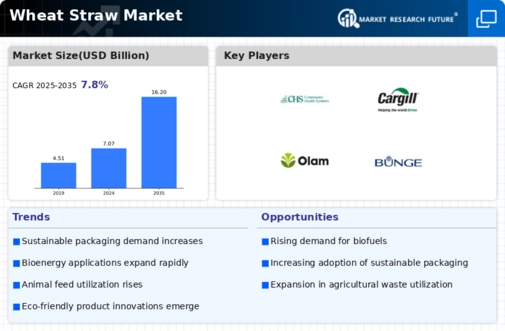Market Growth Projections
The Global Wheat Straw Market Industry is poised for substantial growth, with projections indicating a market value of 7.07 USD Billion in 2024. This growth trajectory is expected to continue, with estimates suggesting a rise to 16.2 USD Billion by 2035. The anticipated compound annual growth rate (CAGR) of 7.84% from 2025 to 2035 highlights the increasing interest in sustainable materials and practices. This growth is driven by various factors, including rising demand for eco-friendly products, government support for sustainable agriculture, and advancements in processing technologies. The market's expansion reflects a broader trend towards sustainability across multiple sectors.
Rising Adoption of Biocomposites
The Global Wheat Straw Market Industry is experiencing a notable increase in the adoption of biocomposites, which incorporate wheat straw fibers into various products. These biocomposites are favored for their lightweight, strength, and eco-friendly properties, making them suitable for applications in automotive, construction, and consumer goods. The growing awareness of the environmental impact of traditional materials is driving manufacturers to explore sustainable alternatives. As a result, the market is projected to grow significantly, with a CAGR of 7.84% anticipated from 2025 to 2035. This trend reflects a broader shift towards sustainable materials in various industries.
Government Initiatives and Regulations
Government initiatives aimed at promoting sustainable agricultural practices are significantly influencing the Global Wheat Straw Market Industry. Various countries are implementing regulations that encourage the use of agricultural residues, including wheat straw, for various applications such as bioenergy and biocomposites. These policies not only support farmers but also contribute to reducing waste and enhancing environmental sustainability. As a result, the market is likely to benefit from increased investments and incentives, fostering innovation and growth in wheat straw utilization. This supportive regulatory environment is expected to play a crucial role in the industry's expansion over the coming years.
Growing Interest in Bioenergy Production
The Global Wheat Straw Market Industry is increasingly linked to the bioenergy sector, as wheat straw serves as a valuable feedstock for biofuel production. With the global push towards renewable energy sources, the utilization of agricultural residues like wheat straw for bioenergy is gaining traction. This trend is further supported by advancements in conversion technologies that enhance the efficiency of biofuel production. As the demand for renewable energy rises, the market for wheat straw is anticipated to grow, potentially reaching 16.2 USD Billion by 2035. This shift towards bioenergy not only contributes to energy security but also promotes sustainable agricultural practices.
Increasing Demand for Sustainable Packaging
The Global Wheat Straw Market Industry is witnessing a surge in demand for sustainable packaging solutions. As consumers become more environmentally conscious, companies are increasingly seeking alternatives to plastic. Wheat straw, being a renewable resource, offers a biodegradable option that aligns with sustainability goals. In 2024, the market is projected to reach 7.07 USD Billion, driven by the growing preference for eco-friendly materials. This trend is expected to continue, with the market potentially expanding to 16.2 USD Billion by 2035, reflecting a compound annual growth rate (CAGR) of 7.84% from 2025 to 2035.
Innovations in Wheat Straw Processing Technologies
Innovations in processing technologies are transforming the Global Wheat Straw Market Industry, enhancing the efficiency and versatility of wheat straw applications. Advances in techniques such as pulping, fiber extraction, and chemical treatments are enabling the production of high-quality products from wheat straw. These innovations not only improve the economic viability of utilizing agricultural residues but also expand the range of applications, including textiles, paper, and construction materials. As the industry embraces these technological advancements, it is likely to attract investments and foster growth, contributing to the overall expansion of the wheat straw market.















